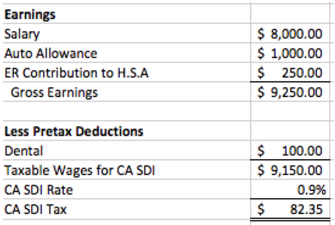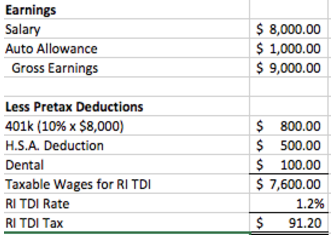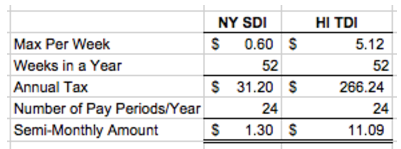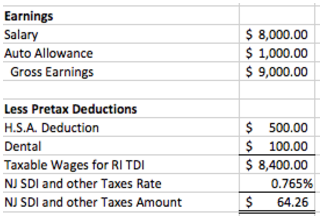What Does Sdi Stand for on My Paycheck
In my recent posts, we've discussed how payroll taxes are calculated across many different areas; state income taxes, social security and medicare taxes, federal income tax withholding and more. Today we'll dive into state disability insurance (SDI) and how it is calculated. The five states listed below are the five that have a form of SDI or temporary disability insurance (TDI) that are withheld from employee paychecks.
| State | Rate | Max Withheld | Annual Wage Max |
| California | 0.900% | $998.12/year | $110,902 |
| Rhode Island | 1.200% | $817.20/year | $ 68,100 |
| New Jersey* | 0.765% | $256.28/year | $ 33,500 |
| Hawaii | 0.500% | $ 5.12/week | – |
| New York | 0.500% | $0.60/week | – |
*This is a total of the New Jersey employee SDI, unemployment, workforce development, and family leave insurances.
California State Disability Insurance (SDI)
California employers are required to withhold state disability insurance from employee paychecks at a rate of 0.9% on wages up to a maximum of $110,902 for 2017. The California State Disability Insurance (SDI) program provides short-term disability insurance and paid family leave wage replacement benefits to eligible workers.
The wages are determined as follows:
Gross Pay (including tips and taxable fringe benefits including employer contributions to HSA plans).
- Less: Section 125 deductions (medical, dental, vision, dependent care, pre-tax commuter benefits, etc.) HSA deductions are not subtracted.
- Equals: Wages for CA SDI
Example: Bob is paid semi-monthly. On this paycheck, he earned $8,000 in salary. In addition, Bob gets a semi-monthly auto allowance of $1,000. He has an HSA deduction of $500, and his employer contributes $250 to his HSA. Bob has a dental deduction of $100 and he also contributes 10% of his income to his 401k. What's Bob's taxable income for CA SDI?

*401(k) and HSA deductions do not reduce gross pay for calculating California SDI.
Rhode Island Temporary Disability Insurance (TDI)
Rhode Island requires employers withhold 1.2% of the first $ 68,100 of employee wages for Temporary Disability Insurance. The insurance protects workers against wage loss resulting from a non-work related illness or injury, and is funded exclusively by Rhode Island workers. The calculation is similar to California, but the definition of wages is different. Rhode Island does not increase wages for employer contributions to HSA, and deferred compensation reduces the wages in the tax calculation. In our example for Bob above, Rhode Island TDI would be calculated as follows:
Example: Rhode Island TDI based on Bob's information above:

New Jersey Disability, Unemployment, Family Leave, and Worker's Development Insurance
New Jersey requires the withholding on employee taxes for state disability, unemployment, family leave, and workforce development insurance (the employer also pays taxes on this as well). The employee tax rates for New Jersey are broken down as follows:
| Employee Tax | Rate |
| State Unemployment Tax Act (SUTA) | 0.3825% |
| State Disability Insurance (SDI) | 0.2400% |
| Workforce Development (WFI) | 0.0425% |
| Family Leave Insurance (FLI) | 0.1000% |
| Total Tax Rate | 0.7650% |
The wages used to calculate the taxes are reduced by benefit deductions, but deferred income does not reduce these wages. If we use Bob as our example again, his New Jersey SDI, SUTA, WFI, and FLI taxes would be calculated as follows:
Example:NJ SDI, SUTA, WFI & FLI taxes based on Bob's information above:
Hawaii TDI
Employers in Hawaii are required by law to provide temporary disability insurance (TDI) coverage for eligible employees. This helps to cover non-work related injury or sickness, including pregnancy. Employers can choose to cover the entire cost, or to withhold up to 0.5% of eligible employees' wages (up to 5.12 per week) towards the cost. Learn more here.
Employers can purchase TDI from an authorized insurance carrier or establish a self-funded plan. Payroll providers will withhold TDI taxes from employees if their employer elects to have employees contribute, but will not pay the amounts to the carrier. The funds remain in the company's account, and the employer is responsible for paying these amounts to the carrier.
New York SDI
Similar to Hawaii, employers in New York are required by law to provide SDI (State Disability Insurance) coverage for eligible employees to cover off-the-job injury or illness. Employers can choose to cover the entire cost or withhold $0.60/week of eligible employees' wages to share the cost of coverage. Payroll providers can withhold these SDI amounts from employees, but will not pay those funds to the carrier. Learn more.
Example:Here is how Bob's semi-monthly Hawaii TDI and New York SDI would be calculated:

As we have seen, there are only five states with State or Temporary Disability taxes, and each have their own system for calculating the withholding. California, Rhode Island, and New Jersey administer the state disability insurance. Hawaii and New York expect employers to have their own insurance policies, but allow employers to withhold some amounts to help pay for those policies.
Bookmark(0)
Please login to bookmark
No account yet? Register



Matthew Keller
Matthew Keller is a Senior Payroll Specialist at Zenefits who authors our "Money Matters" column. With 20+ years of experience in payroll and accounting, Matt wants to help customers navigate frequent law changes, taxes, and more.
What Does Sdi Stand for on My Paycheck
Source: https://www.zenefits.com/workest/how-are-payroll-taxes-calculated-state-disability-insurance/
